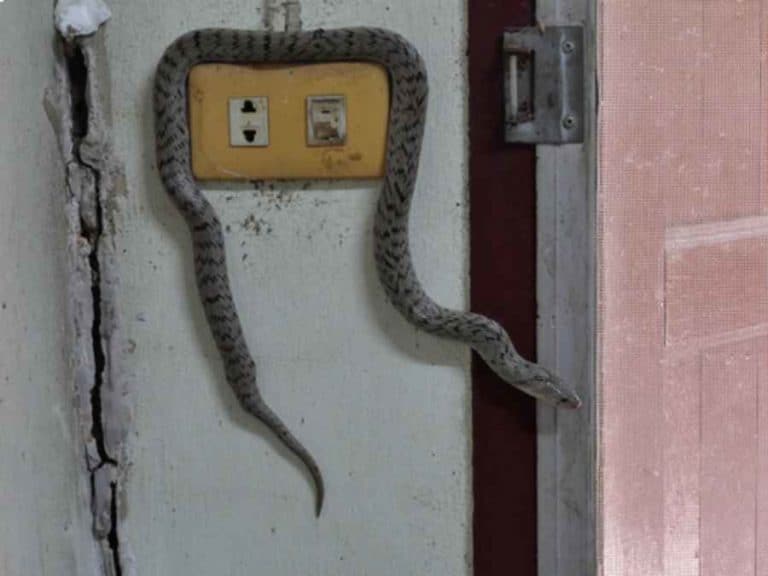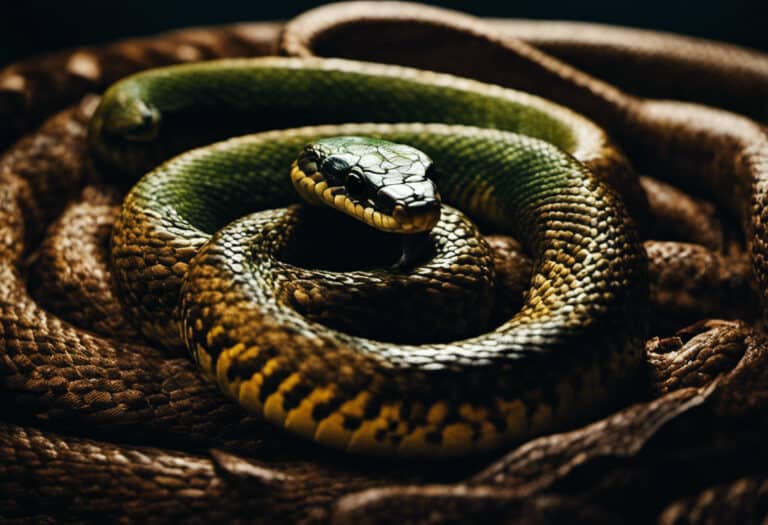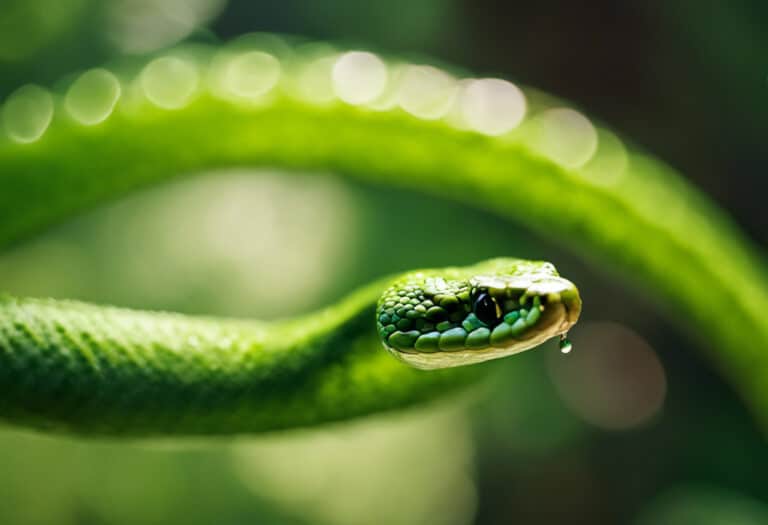Biggest Animal a Snake Can Eat?
Ever wondered just how big of an animal a snake can devour? Well, get ready to be amazed! In this article, we’ll delve into the world of snake jaw structure and their incredible ability to eat large prey.
You’ll learn how these slithering reptiles open their mouths wide, without unhinging their jaws. From worms to cows, we’ll explore the mind-boggling examples of the biggest animals snakes have consumed.
And let’s not forget the vital role they play in maintaining ecosystems. Get ready to be blown away by the wonders of snake evolution and diversity!
Key Takeaways
- Snakes use a specialized collection of skull bones, ligaments, and muscles to open their mouths incredibly wide, and the size of their gape determines the upper limit on the size of prey they can eat.
- Snakes have evolved traits that allow them to catch, swallow, and digest large prey, and they can eat a variety of animals, including earthworms, mollusks, and mammals.
- Different snake lineages have independently evolved the ability to eat large prey, and examples of large prey eaten by snakes include young white-tailed deer, alligators, cows, and occasionally humans.
- Snakes play a critical role in maintaining balance in ecosystems by controlling populations of rodents and other small animals, contributing to natural pest control in agricultural areas, and regulating prey populations to maintain biodiversity.
The Limitations of Snake Jaw Structure
When it comes to the limitations of a snake’s jaw structure, you’ll find that the size of their gape determines the largest animal they can eat.
Snakes have a specialized collection of skull bones, ligaments, and muscles that allow them to open their mouths incredibly wide. Contrary to popular belief, snakes don’t unhinge or dislocate their jaws. Instead, their jaws are attached to ligaments, which provide flexibility and stretching.
This flexibility enables snakes to consume prey larger than their own head. During digestion, snakes use the bones in their head and jaw to move forward on larger prey, aiding in the mechanism of digestion.
However, there are still limitations to jaw flexibility, and the upper limit on the size of prey a snake can eat is ultimately determined by the size of their gape.
Adaptations for Eating Large Prey
To catch and consume larger prey, you’ve evolved specialized adaptations in your jaw structure and flexibility. These adaptations allow you to open your mouth incredibly wide, determining the upper limit on the size of prey you can eat.
Contrary to popular belief, your jaws don’t unhinge or dislocate. Instead, your jaw is attached to ligaments, allowing for flexibility and stretching. This unique jaw structure enables you to move forward on larger prey during digestion.
As a result, you can eat a variety of animals, including earthworms, mollusks, and even mammals. Your lack of limbs and specialized teeth for holding and chewing makes swallowing whole the most efficient method.
Different snake lineages have independently evolved the ability to eat large prey, showcasing the remarkable diversity of snake adaptations.
Impressive Examples of Snakes’ Prey Size
You are capable of swallowing prey that has a much larger size and weight compared to your own.
Snakes have evolved remarkable adaptations that allow them to consume a wide range of prey sizes. From the smallest earthworms to large mammals, snakes exhibit an impressive ability to catch, swallow, and digest their prey.
While most snakes are content with smaller prey like worms or mice, there are unique instances of snakes consuming unusually large or unexpected animals.
For example, Burmese pythons have been documented eating young white-tailed deer, and there have been rare incidents of snakes consuming humans, alligators, and even cows.
The size and gape of individual snakes vary, making it difficult to determine the largest animal a snake can swallow. However, their ability to consume such a variety of prey sizes showcases their remarkable adaptability and importance in maintaining balance in ecosystems.
Snakes’ Ecological Importance
Snakes’ presence in ecosystems helps regulate prey populations and maintain biodiversity. As apex predators, snakes play a crucial ecological role in maintaining ecosystem balance. They control populations of rodents and other small animals, contributing to the natural control of pests in agricultural areas.
Snakes occupy diverse habitats and are found in various ecosystems worldwide. Their ability to eat a variety of animals, including earthworms, mollusks, and mammals, allows them to efficiently regulate prey populations. By doing so, they prevent overpopulation of certain species and ensure the survival of others.
Snakes’ role as apex predators helps maintain the delicate balance of Earth’s food webs. Their presence isn’t only important for the functioning of ecosystems, but also for the overall biodiversity of our planet.
Exploring Snake Evolution and Diversity
As you explore snake evolution and diversity, you’ll discover the tremendous variation in their diet and feeding habits.
Snakes have developed a range of feeding strategies to adapt to their diverse habitats. Some snakes are specialized hunters, targeting specific prey items such as fish or birds. Others are generalists, capable of eating a wide variety of animals.
Their habitat diversity plays a crucial role in shaping their feeding strategies. Snakes in aquatic environments may rely on stealth and ambush tactics to catch fish, while tree-dwelling snakes may use their agility to snatch birds from the air. Ground-dwelling snakes often employ constricting methods to subdue their prey.
Overall, snake feeding strategies are a testament to their adaptability and resourcefulness in different habitats.
Frequently Asked Questions
How Do Snakes Open Their Mouths so Wide to Eat Large Prey?
Snakes open their mouths wide through the flexibility of their jaws. This allows them to catch and eat large prey. The benefits include efficient swallowing and digestion, as well as the ability to survive on fewer calories.
Do Snakes Dislocate Their Jaws to Eat?
No, snakes don’t dislocate their jaws to eat. Their jaw anatomy includes specialized bones, ligaments, and muscles that allow for flexibility and stretching. This mechanism enables them to open their mouths incredibly wide, without dislocation.
What Types of Animals Can Snakes Eat?
Snakes can eat a variety of animals, including earthworms, mollusks, and mammals. They lack limbs and specialized teeth, so swallowing whole is their most efficient method. Their digestion process is fascinating.
Can Snakes Eat Humans?
Snakes can eat humans, although such incidents are rare. It’s important to note that not all snakes are capable of consuming large prey, and their ability to do so depends on factors like size and jaw structure.
What Role Do Snakes Play in Maintaining Ecosystems?
Snakes play a vital role in ecosystems as both predators and prey. They help control populations of rodents and pests, maintaining balance in food webs. Snakes’ presence ensures biodiversity by regulating prey populations, making them essential for a healthy environment.
Conclusion
As we conclude our exploration into the world of snakes and their ability to consume large prey, we’re left in awe of their remarkable jaw structure and adaptability. These slithering reptiles, with their flexible ligaments and muscles, can open their mouths wide enough to devour prey much larger than themselves.
Their impressive feat symbolizes the intricate balance of nature, where every creature has a vital role to play. Snakes, with their ecological importance in controlling populations and maintaining biodiversity, remind us of the interconnectedness of all living organisms in our ecosystems.






